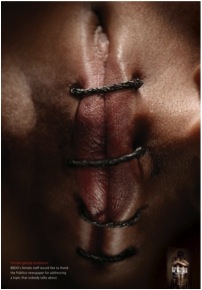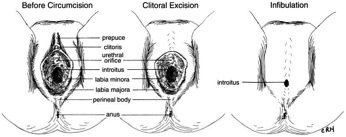Serendip is an independent site partnering with faculty at multiple colleges and universities around the world. Happy exploring!
Female Genital Mutilation
Rebecca Sheriff
Female Genital Mutilation

Female genital mutilation (FGM), also known as female genital cutting is a
practice that has been going on for thousands of years based in northern Africa, the
Middle East, and parts of south Asia. Although there are claims that FMG is done for
religious reasons, there are no passages in the Koran, Bible, or Torah supporting FGM.
Because FGM has no health benefits, but instead serious health risks, including death, the
World Health Organization (WHO), Human Rights Watch, and countless other
organizations are trying to put an end to it. Many countries including western nations that
have immigrants from the main countries of FGM , have made FGM illegal. Several
politicians and activists have proposed implementing mandatory gynecological exams in
elementary schools for at risk students, but this has been rejected. The governments of
these countries who have outlawed FGM are working with many organizations like
UNICEF, Amnesty International, and WHO to take preventative measures, which mainly
consist of spreading education on the affects of FGM.
Female genital mutilation is classified into four groups. Type 1 is the excision of
the clitoral hood, usually as well as the clitoris. Type 2 is the excision of the clitoris and
inner labia. Type 3 is commonly called infibulation, which consists of cutting off all
external genitalia, and then binding the girl’s legs together for 2-6 weeks so a scar will
form over the opening of the vulva. Before this huge scar is formed, a twig is usually
stuck in between the flesh to create a small hole for urine and menstrual blood to flow
from. The hole that is produced is initially made small enough to prevent women from
having sex, but this is problematic because the small opening obstructs blood and urine
flow, which causes infection. When a girl who has infibulation is about to have sex the
man either tries to force his penis through the hole, or has to cut it with a knife which
frequently results in organ damage, urinary incontinence, obstetric fistula, and death (7).
Type 4 includes the following damage to female genitalia: pricking, piercing, burning,
cutting, applying corrosive substances to tighten it, and cutting into the vagina to widen it
(7). FGM has many harmful effects such as: hemorrhaging, urinary infection, hepatitis
and HIV (due to unsterile tools), pelvic infections, epidermoid cysts, and infertility (5).
The pictures and charts below can help conceptualize this information.

Chronic FGM-Related Complications Encountered by Health
Providers in Kenya

FGM is practiced in 28 African countries, with incidence varying from 98% of
women in Somalia to 5% is Zaire. FGM is also found in Oman, the United Arab
Emirates, and Yemen, as well as in parts of India, Indonesia, and Malaysia. Immigrants
from these countries to Europe, Canada, and the United States continue to undergo FGM.
Overall 85% of women who have FGM have Types 1 and 2, and 15% of females have
Type 3; but some countries like Somalia, Sudan, and Djibouti have almost exclusively
Type 3. Approximately 100-140 million females have undergone FGM, with an
additional 3 million girls and women undergoing FGM every year. The following picture
is shows the prevalence of FGM in Africa.

Many people claim that FGM is necessary to be a ‘good Muslim,’ but there are no
passages in the Koran that support this; in fact the Koran states that it is forbidden to
mutilate God’s creation. In Sura 95, Verse 4, the Koran states: “We have created man in
our most perfect image”. Islam, Christianity, and Judaism “define man as a perfect
creation of the Almighty, and condemn doing any harm to God’s creation” (8). Women
from countries with high rates of FGM are afraid of not being cut because they will be
perceived as being unclean, and can have trouble finding a husband. Myths are spread
around in FGM areas that the clitoris grows so big it will rub your clothes and be
uncomfortable. The following graph shows the beliefs of FGM in certain African
countries.
Reasons for Supporting FGM in Egypt, Mali, Central African Republic,
and Eritrea

FGM violates many human rights charters, and organizations’ beliefs. The
following is an example of the countless violations people feel FGM creates. The
African (Banjul) Charter on Human and Peoples’ Rights take objection with the
following aspects of FGM: the right to life could be violated, the right to health could be
violated, the right to physical integrity could be violated, which includes freedom from
violence, the right not to be subjected to torture or ill treatment could be violated, the
right to non-discrimination could be violated, and specific children’s rights could be
violated (8).
Because many people consider FGM a violation of human rights of girls and
women, countries have been outlawing this practice since the 1980s. Because the U.S.
and European countries have received immigrants who practice FGM, these countries
have started penalizing FGM. Sweden was the first western country to pass legislation
banning FGM in 1982. Since 1982 the following industrialized nations have passed laws
criminalizing FGM: Australia, Belgium, Canada, Cyprus, Denmark, Italy, New Zealand,
Norway, Spain, Sweden, United Kingdom, and United States. France uses existing
criminal legislation to prosecute both people who perform FGM and parents who get the
service for their daughters. The following African nations have made criminal legislation
banning FGM: Benin, Burkina Faso, Central African Republic, Chad, Côte d'Ivoire,
Djibouti, Egypt, Eritrea, Ethiopia, Ghana, Guinea, Kenya, Mauritania, Niger, Senegal,
South Africa, Tanzania, Togo, and Nigeria (1). The penalties range from 3 months to life
in prison, as well as monetary fines.
In some countries like England and France, you can be prosecuted even if you
send your daughter abroad to get FGM. “In the UK, the Prohibition of Female
Circumcision Act 1985 outlawed the procedure in Britain itself, and the Female Genital
Mutilation Act 2003 and Prohibition of Female Genital Mutilation (Scotland) Act 2005
made it an offence for FGM to be performed anywhere in the world on British citizens or
permanent residents.” (5). Although so many countries have outlawed FGM, it is very
hard to monitor because it involves genitalia. Former member of the Dutch Parliament,
Ayaan Hirsi Ali, activist Kadra Yosuf, politician Nyamko Sabuni, and others have
proposed a mandatory physical examination among girls from the risk group. Ayann
Hirsi Ali proposed that these examinations happen in grade school, with the hope to
discourage female circumcision. The Dutch parliament said that was not possible because
“(1) it would be considered discriminatory to only let girls and women from specific
countries undergo a physical examination; (2) the Dutch law does not provide for the
possibility of a mandatory physical examination in FGM cases; (3) a compulsory physical
medical examination would interfere too much with the private life of a person and would
therefore violate article 10 of the Dutch Constitution, article 17 ICCPR, and article 8
ECHR” (8).
The main way governments, NGO’s, and social justice groups are trying to
combat FGM is through prevention by empowering women with education. The
following are examples of prevention. The Inter-African Committee on Traditional
Practices, with the help of NGO’s has started an extensive educational campaign in over
20 African countries, with the goal of eliminating FGM. The United States is trying to
eliminate FGM through policies that include education, the empowerment of women, and
enforcement of laws against FGM. The Dutch prevention policy consists of awareness
raising, education and training of medical professionals and health-care workers, and the
empowerment of women.
Although people are attempting to eliminate FGM, organizations such as
Amnesty International want to respect culture by replacing physical FGM with symbolic
ceremonies. The main goal of eliminating FGM is for female’s integrity and safety, not to
ignore traditions that include a rite of passage (9).
Bibliography
1) http://reproductiverights.org/en/document/female-genital-mutilationfgm-
legal-prohibitions-worldwide
2) http://reproductiverights.org/sites/crr.civicactions.net/files/documents/B
RB_FGM_10.08.pdf
3) http://www.ednahospital.org/hospital-mission/female-genitalmutilation/
4) http://www.socialcohesion.co.uk/files/1231525439_1.pdf
5) http://en.wikipedia.org/wiki/File:FGC_Types.svg
6) http://www.path.org/files/FGM-The-Facts.htm
7) http://www.ednahospital.org/hospital-mission/female-genitalmutilation/
8) http://www.stopfgm.net/dox/SPoldermansFGMinEurope.pdf
9) http://www.global-sisterhood-network.org/content/view/1470/59/
10) http://feminist.org/global/fgm.html



Comments
photo of sewn vagina
Dear Rebecca,
I am a Sex Educator putting together a large, inclusive web site and would like to include the powerful photograph in your article for the section on FGM. Would that be okay?
And thank you so much for putting this strong, well-researched article on the web!
-Shain Stodt
Genital surgeries?
buffalo--
you've done a power of research about a very controversial issue, one that highlights the questions of cultural difference that you gesture towards just @ the close of your study. I'd appreciate fuller citation for each of your sources--your list of url's doesn't tell me who wrote this material, under what circumstances, or on what dates.
If you'd like to go on thinking about these issues for your next project, I'd recommend your beginning (again) in two directions: first, by finding out more about how women on whom these procedures are performed (and who perform these procedures on their own daughters and nieces) describe and justify their practices; secondly, by learning more about genital surgeries conducted in this country, both on little boys (= male circumcision) and on infants w/ ambiguous genitalia. For the first topic, some sources include
Warrior Marks. Dir. Pratibha Parmar. Videocassette. Hauer Rawlence, 1993. 54 minutes.
Fire Eyes. Dir. Soraya Mire. Videorecording. Persistent Productions,1994. 60 minutes.
Dorkenoo, Efua and Scilla Elworthy. “Female Genital Mutilation: Proposals for Change.” London: Minority Rights Group, 1992.
Lane, Sandra and Robert A. Rubinstein. “Judging the Other: Responding to Traditional Female Genital Surgeries.” Hastings Center Report 26, 3 (1996): 31-40.
for the second, see, for starters,
Slaughenhaupt, Bruce. “Diagnostic Evaluation and Management of the Child With Ambiguous Genitalia.” The Journal of the Kentucky Medical Association 95 (April 1997): 135-141.
Erik Parens. “Thinking about Surgically Shaping Children.” Surgically Shaping Children: Technology, Ethics, and the Pursuit of Normality. Johns Hopkins, 2006. xiii-xxx.
As with your last web-event, by suggesting these readings, I'm nudging you towards a project that frames the issues less starkly as "pro" and "con," as "us" vs. "them," placing the questions you raise and the answers you offer on more of a nuanced continuum. You might want to look, too, @ the work of some of your classmates that looks @ feminism "across geographies"....